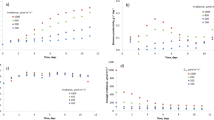Abstract
Eicosapentaenoic (EPA) and docosahexaenoic (DHA) acid productivities from chemostat cultures of an isolate of Isochrysis galbana have been studied. The productivities reached in the interval of dilution rates between 0.0295 h−1 and 0.0355 h−1 were 1.5mg·1−1·h−1 for lipids, 300 μg·1−1·h−1 for EPA and 130μg1·1−1·h−1 for DHA. Furthermore, light attenuation by mutual shading, and agitation speed influences on growth and fatty acid composition were analysed. A model relating steady-state dilution rates to internal average light intensity has been proposed, the parameter values of which obtained by non-linear regression were: maximum specific growth rate (μmax)=0.0426 h−1; the affinity of cells to light (Ik) = 10.92 W·m−2; the exponent (n) = 5.13; regression coefficient (r 2)=0.9999.
Similar content being viewed by others
References
Ben-Amotz A, Avron M (1989) The biotechnology of mass culturing of Dunaliella for products of commercial interest. In: Creswell RC, Rees TA, Shah N (eds) Algal and cyanobacterial technology. Longman, London, p 90
Cohen Z, Vonshak A, Richmond A (1988) Effect of environmental conditions on fatty acid composition of the red alga Porphyridium cruentum: correlation to growth rate. J Phycol 24:328–332
De Pauw N, Persoone G (1988) Micro-algae for aquaculture. In: Borowitzka MA, Borowitzka LJ (eds) Microalgal biotechnology. Cambridge University Press, Cambridge, p 197
Dyerberg J (1986) Linoleate-derived polyunsaturated fatty acids and prevention of atherosclerosis. Nutr Rev 44:125–134
Evers EG (1991) A model for light-limited continuous cultures: growth, shading, and maintenance. Biotechnol Bioeng 38:254–259
Fischer NS, Schwarzenbach RP (1978) Fatty acid dynamics in Thalassiosira pseudonana (Bacillariophyceae): implications for physiological ecology. J Phycol 14:143–150
Forde J, Steer MW (1976) The use of quantitative electron microscopy in the study of lipid composition of membranes. J Exp Bot 27:1137–1141
Goldman JG (1979) Outdoor algal mass culture II. Photosynthetic yield limitations. Water Res 13:119–136
Gudin C, Chaumont D (1991) Cell fragility — the key problem of microalgae mass production in closed photobioreactors. Bioresource Technol 38:145–151
Hansmann E (1973) Pigment analysis. In: Stein JR (ed) Handbook of phycological methods. Culture methods and growth measurements. Cambridge University Press, Cambridge, p 359
Herzig R, Falkowski PG (1989) Nitrogen limitation in Isochrysis galbana (Haptophyceae). I. Photosynthetic energy conversion and growth efficiencies. J Phycol 25:462
James CM, Al-Khars AM (1990) An intensive continuous culture system using tubular photobioreactors for producing microalgae. Aquaculture 87:381–393
Kates M, Volcani BE (1966) Lipid components of diatoms. Biochem Biophys Acta 116:264
Kochert G (1978) Quantitation of the macromolecular components of microalgae. In: Hellebust J, Cragie S (eds) Handbook of phycological methods. Physiological and biochemical methods. Cambridge University Press, Cambridge, p 189
Lepage G, Roy C (1984) Improved recovery of fatty acid through direct transesterification without prior extraction or purification. J Lipid Res 25:1391
López Alonso D, Molina Grima E, Sánchez Pérez JA, Garcia Sánchez JL, Garcia Camacho F (1992a) Isolation of clones of Isochrysis galbana rich in eicosapentaenoic acid. Aquaculture 102:363–371
López Alonso D, Molina Grima E, Sánchez Pérez JA, García Sánchez JL, García Camacho F (1992b) Fatty acid variation among different isolates of a single strain of Isochrysis galbana. Phytochemistry in press
Molina Grima E, Martínez ME, Sáchhez S, García F, Contreras A (1991) Growth and biochemical composition with emphasis on the fatty acids of Tetraselmis sp. Appl Microbiol Biotechnol 36:21–25
Molina Grima E, Sánchez Pérez JA, García Sánchez JL, García Camacho E, López Alonso D (1992) EPA from Isochrysis galbana. Growth conditions and productivity. Process Biochem 27:299–305
Moser A (1985) Kinetics of batch fermentation. In: Rehm HJ, Reed G (eds) Biotechnology vol 2. VCH, Weinheim, p 243
Opute FI (1974) Lipid and fatty acid composition of diatoms. J Exp Bot 25:823–835
Piorreck M, Baasch K, Pohl P (1984) Biomass production, total protein, chlorophylls, lipids and fatty acids of freshwater green and blue-green algae under different nitrogen regimes. Phytochemistry 23:207–216
Renaud SM, Parry DL, Luong-Van, Thinh, Kuo C, Padovan A, Sammy N (1991) Effect of light intensity on the proximate biochemical and fatty acid composition of Isochrysis sp. and Nannochloropsis oculata for use in tropical aquaculture. J Appl Phycol 3:43–53
Richmond A (1988) A prerequisite for industrial microalgaculture: efficient utilization of solar irradiance. In: Stadler T, Mollion J, Verdus MC, Karamanos Y, Morvan H, Chritiaen D (eds) Algal biotechnology. Elsevier, Amsterdam, p 237
Terry KL (1986) Photosynthesis in modulated light: quantitative dependence of photosynthetic enhancement on flashing rate. Biotechnol Bioeng 28:988–995
Thompson PA, Harrison PJ, Whyte NJ (1990) Influence of irradiance on the fatty acid composition of phytoplankton. J Phycol 26:278–288
Utting SD (1985) Influence of nitrogen availability on the biochemical composition of three unicellular marine algae of commercial importance. Aquacult Eng 4:175–190
Whyte JN (1987) Biochemical composition and energy content of six species of phytoplankton used in mariculture of bivalves. Aquaculture 60:231–241
Whyte JN (1988) Fatty acid profiles from direct methanolysis of lipids in tissue of cultured species. Aquaculture 75:193–203
Yongmanitchi W, Ward OP (1991) Screening of algae for potential alternative sources of eicosapentaenoic acid. Phytochemistry 30:2963–2967
Author information
Authors and Affiliations
Additional information
Correspondence to: E. Molina Grima
Rights and permissions
About this article
Cite this article
Molina Grima, E., Sánchez Pérez, J.A., Garcia Camacho, F. et al. n-3 PUFA productivity in chemostat cultures of microalgae. Appl Microbiol Biotechnol 38, 599–605 (1993). https://doi.org/10.1007/BF00182796
Received:
Accepted:
Issue Date:
DOI: https://doi.org/10.1007/BF00182796




